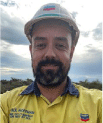Key lessons in planning for proactive decommissioning – a review of the Thevenard Island decommissioning project
Christopher M. Jones A * , Michael B. Boisvert A , Shannon L. Dolbel A , Richard P. Langsford A , George N. Farag A , Kellie A. Rinaldi A , Jennifer D. Brauhart A , Paul Y. Hoffman A and Grant A. Brunsdon AA Chevron Australia Pty Ltd, 256 St Georges Terrace, Perth, WA 6000, Australia.
The APPEA Journal 62(1) 1-13 https://doi.org/10.1071/AJ21216
Submitted: 23 December 2021 Accepted: 21 February 2022 Published: 13 May 2022
© 2022 The Author(s) (or their employer(s)). Published by CSIRO Publishing on behalf of APPEA.
Abstract
Chevron Australia Pty Ltd (CAPL) has operated an oil and gas production facility on Thevenard Island (TVI), a gazetted Nature Reserve, since 1988 on behalf of the TVI Joint Venture. CAPL is currently decommissioning the asset following cessation of production in 2014. Decommissioning activities include plugging and abandonment of onshore and offshore production wells, decommissioning onshore infrastructure and facilities, decommissioning offshore platforms and pipelines, and remediating and rehabilitating the terrestrial environment. CAPL is currently undertaking decommissioning and retirement of its facilities on TVI, including remediation and rehabilitation activities. CAPL is committed to progressing the decommissioning and rehabilitation activities in a timely manner to deliver positive outcomes for environment, local community and other users of TVI. Delivering on historical commitments and applying best practice to ensure the lease area can be relinquished as a functioning and sustainable ecosystem is key to being a responsible operator and maintaining social licence to operate. This paper will provide an overview of decommissioning activities and progress to date, with a focus on onshore operations, and discuss challenges encountered as well as lessons learnt from decommissioning planning and sequencing, implementation of the regulatory framework and in-field execution.
Keywords: care and maintenance, cessation of production, decommissioning, hazardous materials, HSE risk management, infrastructure removal, investigations, learning culture, planning, proactive, regulatory approvals, rehabilitation, remediation, retirement, sequencing, stakeholders, Thevenard Island, waste, well plug and abandonment.

Chris Jones has a broad experience base across onshore and offshore decommissioning and has a wealth of real world execution experience to draw upon, having previously managed the removal of over 40 structures and associated pipelines in the Gulf of Mexico as well as overseeing high profile onshore decommissioning and remediation sites in California. He leverages the lessons learnt from those experiences in his current role where he manages the onshore and offshore decommissioning of Chevron’s Thevenard Island Asset. Chris represents Chevron Australia across the decommissioning space and is active in both the global and local decommissioning industry communities. His background in marine and environmental science coupled with extensive planning and execution experience across multiple regulatory regimes has provided Chris with a unique understanding of asset retirement. |

Michael Boisvert received a Bachelor of Multidisciplinary Science (Biology) with Honours from Curtin University in 1997. Michael started his professional career work in the mining and exploration industry as an Environmental Officer in Western Australian Eastern woodlands and focused on mine site decommissioning planning and execution. In 2001 Michael moved to consulting where he focused on mine site rehabilitation monitoring and closure planning for mines in the Goldfields and Pilbara. In 2004 Michael started as an Environmental Specialist with Chevron Australia on Barrow Island where a large focus was on rehabilitation and contaminated site remediation. He spent 3 years in California as a Project Manager for Chevron’s Environmental Management Company undertaking facility decommissioning and well abandonment. After moving back to Western Australia, he has worked in both decommissioning and operations and is now the Onshore Project Engineer managing the Rehabilitation and Remediation for the Thevenard Island Retirement Project. |

Shannon Dolbel is a Regulatory Affairs Advisor at Chevron Australia focused on regulatory approvals associated with decommissioning, covering both State and Commonwealth jurisdictions and onshore and offshore environments. Shannon graduated from Murdoch University in Western Australia in 2003 with Bachelor of Science in Conservation Biology and in 2007 with a Bachelor of Science in EcoTourism. Shannon has worked overseas in the United Kingdom and in Australia working across government, environmental consulting and the oil and gas industry in environmental management and environmental approvals, including on Chevron’s Gorgon and Wheatstone Projects. Shannon is now the Regulatory Affairs lead for the Thevenard Island Retirement Project and responsible for environmental and petroleum related approvals. |

Richard Langsford is currently the Thevenard Island Decommissioning Project Engineer at Chevron Australia. He has a Bachelor of Engineering Degree (Hons) in Civil and Construction Engineering and has over 15 years’ experience in the energy business with Chevron, both in Australia and the USA. Richard has held numerous positions within Chevron across Brownfield Project Management and Execution, Engineering Management supporting Operating Assets and Decommissioning Project Management and Execution. |

George Farag is a Drilling Engineer at Chevron Australia. George graduated from the University of Western Australia with a Bachelor’s Degree in Mechanical Engineering. George has worked in drilling, well servicing and well abandonments for 11 years with experience in deepwater, subsea high rate gas wells to brownfield land well operations. George was the Project Drilling Engineer for the well plugging and abandonment aspect of the TVI Retirement Project. |

Kellie Rinaldi holds a Bachelor of Science (Environmental Science and Marine Science) from Murdoch University. She has 15 years’ experience working across industry, consultancy and regulatory agencies primarily in environmental planning and management. Kellie is presently employed by Chevron Australia as a HSE Specialist for the Thevenard Island Retirement Project. |

Jennifer Brauhart graduated from UNSW Sydney with a Bachelor of Applied Science (Geology) with Honours (Hydrogeology). With more than 25 years of career experience in hydrogeology, natural resource management, environmental science, contaminated site assessment and remediation, Jennifer has undertaken roles in government, environmental consulting and the oil and gas industry across Australia. In her current role, she is a remediation subject matter expert with Chevron Australia. Jennifer is responsible for management of environmental monitoring, contaminated site investigation, human health and ecological risk assessment and remediation across Chevron’s Australian Assets with a key focus on the development and execution of remediation management strategies to support decommissioning of redundant assets and site re-classification. |

Paul Yagan Hoffman is the Rehabilitation/Restoration Specialist at Chevron Australia. After completing a Bachelor of Science (Hons) in Natural Resource Management at the University of Western Australia, he has worked in a diverse range of industries spanning agriculture/horticulture, mining and resources, botany and ecology, prior to joining Chevron in 2011. Paul is currently a member of the Pilbara Rehabilitation Group and participant in CRC-TIME. |

Grant Brunsdon attained a Bachelor of Engineering (Naval Architecture) degree with honours from the Australian Maritime College, graduating in 1996. After graduating he commenced work as a Naval Architect at Austal Ships designing and constructing high-speed aluminium vessels. Grant is a member of the Royal Institute of Naval Architects. After 10 years in ship building, Grant moved into the oil and gas industry, initially working for offshore installation contractors. In 2010 Grant commenced as a senior project engineer on the transport and installation of one of WA’s largest offshore installations. Following this he started working in oil and gas decommissioning. At Chevron Australia, Grant has worked on the Thevenard Island Retirement Project, initially overseeing the CoP and early onshore decommissioning of Thevenard Island. He is currently the lead offshore project engineer for the project, responsible for the removal of nine platforms, pipelines and associated subsea infrastructure. |
References
DEP (2004) ‘Contaminated sites management series – Use of monitored natural attenuation for groundwater remediation.’ (Department of Environmental Protection: Perth, WA). Available at https://library.dbca.wa.gov.au/static/FullTextFiles/070922.pdfDWER (2014) ‘Guideline – Assessment and management of contaminated sites.’ (Department of Water and Environmental Regulation: Joondalup, WA). Available at https://www.der.wa.gov.au/images/documents/your-environment/contaminated-sites/guidelines/Assessment_and_management_of_contaminated_sites.pdf
NEPC (2013) ‘National Environment Protection (Assessment of Site Contamination) Measure 1999.’ (National Environment Protection Council). Available at http://www.nepc.gov.au/nepms/assessment-site-contamination
Standards Australia (2001) The demolition of structures (AS 2601-2001) [Standard]. Available at https://store.standards.org.au/product/as-2601-2001
Young RE, Manero A, Miller BP, Kragt ME, Standish RJ, Jasper DA, Boggs GS (2019) ‘A framework for developing mine-site completion criteria in Western Australia.’ (The Western Australian Biodiversity Science Institute: Perth, Western Australia)


